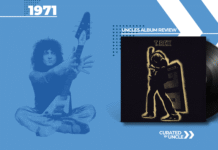Sticky Fingers (1971): Rock ‘n’ Roll’s Most Stylish Midlife Crisis
Some albums seduce you gently. Sticky Fingers kicks the back door off its hinges and offers you cocaine off a switchblade. It’s not just a record, it’s a grimy handshake from the devil wearing snakeskin boots and a smirk.
Released in 1971, during the era when rockstars were basically untouchable gods in flared trousers, Sticky Fingers was The Rolling Stones’ first album released under their own label and they wasted absolutely no time in making it as gloriously self-indulgent, emotionally erratic, and morally questionable as possible.
This is not the Stones “finding themselves.” This is the Stones snorting themselves.
Table of Contents

Act I: “Brown Sugar” – A Banger With a Side of Yikes
Let’s not pretend otherwise: Brown Sugar is one of the catchiest songs ever written. That riff? A five-second summary of rock ‘n’ roll at its filthiest, most unapologetic core. It’s got swagger, drive, and Mick Jagger’s vocals riding the groove like it owes him rent.
But then… you actually listen to the lyrics.
The song opens with references to slavery, rape, and drug use, and doesn’t exactly ease off the gas. It’s like someone set a history textbook on fire and danced around it with a guitar solo.
Critics have rightfully dragged the song for its content, but that’s also what makes Sticky Fingers the warped cultural artefact it is. It’s offensive. It’s brilliant. It’s a time capsule of an era when rock was less about morals and more about what you could get away with while grinning.
In short: “Yikes, but also… yeah, that riff slaps.”
Act II: “Sway” – The Hangover Kicks In
After the high of Brown Sugar, Sway drifts in like a depressive cloud after a three-day bender. There’s no pretending here Jagger is sliding into emotional murkiness, crooning about life being hard, people being liars, and how everything is awful but set to a surprisingly sexy guitar line.
It’s moody. It’s poetic. And it sounds like something you’d listen to while staring at your reflection in a cracked mirror wondering where it all went wrong.
Keith Richards is notably absent on this one possibly because he was too busy being Keith Richards. But Mick Taylor’s slide guitar solo more than makes up for it, soaring in like an anguished scream from a bottle of Jack Daniels.
Act III: “Wild Horses” – Vulnerability in Cowboy Boots
Yes, it’s been played to death in coffee shops and coming-of-age film trailers, but Wild Horses is still devastatingly good. It’s vulnerable, restrained, and shockingly human for a band better known for looking like they just crawled out of a strip club.
The melody is heartbreakingly simple, the lyrics unusually honest. For a brief, flickering moment, you believe that Jagger actually has feelings before he saunters off again into emotional unavailability and sunglasses.
And let’s not forget, the song’s origins are as murky as its tone. Depending on the interview, it was written about Marianne Faithfull, Keith Richards’ newborn son, or possibly Mick just having a really sad sandwich. No one knows. It’s perfect.
Act IV: “Can’t You Hear Me Knocking” – Seven Minutes of Pure, Unfiltered What-The-Hell
This song is like two songs duct-taped together by someone on LSD in a velvet blazer, and it works.
The first half is classic Stones: funky, raunchy, loose. But then, out of nowhere, the track just keeps going. It melts into a five-minute instrumental jam so unexpected, you’d be forgiven for thinking someone changed the radio station. Congas appear. Saxophones wail. Guitars noodle like they’ve lost the will to find a chord.
It’s chaotic. It’s unnecessary. It’s brilliant. Like the band briefly forgot they were recording an album and just decided to have a mystical jazz-rock séance instead.
Act V: “Sister Morphine” – The Ballad of the Bleak
And here’s where the party officially dies.
Sister Morphine isn’t a song, it’s a descent. It crawls through the gutter with bloodshot eyes and a cold sweat. It’s the sound of regret, addiction, and the gentle realisation that maybe, just maybe, this whole lifestyle might have consequences.
Originally co-written with Marianne Faithfull (who was unceremoniously uncredited for years because – surprise – it was the ‘70s), it’s bleak, sparse, and haunting. Jagger sounds sedated, the piano feels like it’s echoing from a hospital corridor, and the guitars twitch like veins in withdrawal.
Not exactly a feel-good summer anthem, but a standout nonetheless.
The Artwork: When Your Album Has a Zipper. Literally.

Let’s not pretend that Sticky Fingers’ fame doesn’t partially rest on the infamous cover: a close-up of denim-clad male crotch with a working zipper. Andy Warhol designed it, because of course he did. He probably charged a small fortune and considered it performance art.
Yes, the zipper scratched the vinyl. Yes, it was a nightmare for pressing plants. Yes, it was completely gratuitous.
But it was also perfect. Because Sticky Fingers isn’t about subtlety. It’s about swagger, sex, and shocking your nan.
The cover is the album in miniature: bold, suggestive, ridiculous, and impossible to ignore.
Legacy: Still Sticky After All These Years
Fifty years on, Sticky Fingers remains one of the most iconic, uneven, and emotionally unhinged albums in rock history. It’s a drunken masterpiece: brilliant, problematic, weirdly vulnerable, and far better than it has any right to be considering how much heroin was involved.
It’s also the first album to feature the now classic “tongue and lips” logo. Which, let’s face it, is probably the most recognisable oral fixation since Dracula.
But beyond the imagery and scandal, Sticky Fingers captures The Rolling Stones at a crucial turning point fully embracing excess while still capable of genuine depth. It’s the album equivalent of a wrecked limousine filled with poetry.
My Final Thoughts: Zip Up, Plug In, Drop Out
In the end, Sticky Fingers is everything rock ‘n’ roll should be: loud, lewd, unpredictable, and covered in emotional bruises. It’s an album that doesn’t care if you like it, but dares you to ignore it.
Some albums age like fine wine. This one ages like bourbon: sharp, fiery, and likely to start a fight.
So pour yourself a stiff drink, drop the needle, and prepare to be emotionally assaulted. Just don’t blame the band when you wake up the next morning and question your life choices.

If You Like Sticky Fingers, I Recommend These Albums:
Exile on Main St. – The Rolling Stones (1972) – The Stones go full swamp-rock hangover and somehow make chaos sound sexy.
Electric Warrior – T. Rex (1971) – Like Sticky Fingers in glitter and platform boots, oozing glam and groin.
Let It Bleed – The Rolling Stones (1969) – Their darker, dirtier older brother — all menace, no apologies.

Sticky Fingers (Remastered)
| # | Track | Duration |
|---|---|---|
| 1 |
Brown Sugar - Remastered 2009
The Rolling Stones
|
03:48 |
| 2 |
Sway - 2009 Mix
The Rolling Stones
|
03:52 |
| 3 |
Wild Horses - 2009 Mix
The Rolling Stones
|
05:41 |
| 4 |
Can't You Hear Me Knocking - 2009 Mix
The Rolling Stones
|
07:16 |
| 5 |
You Gotta Move - 2009 Mix
The Rolling Stones
|
02:32 |
| 6 |
Bitch - 2009 Mix
The Rolling Stones
|
03:37 |
| 7 |
I Got The Blues - 2009 Mix
The Rolling Stones
|
03:53 |
| 8 |
Sister Morphine - 2009 Mix
The Rolling Stones
|
05:31 |
| 9 |
Dead Flowers - 2009 Mix
The Rolling Stones
|
04:04 |
| 10 |
Moonlight Mile - 2009 Mix
The Rolling Stones
|
05:57 |












